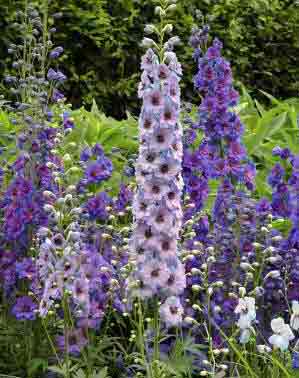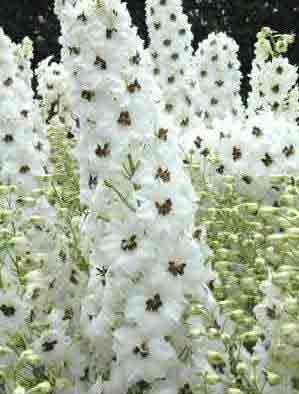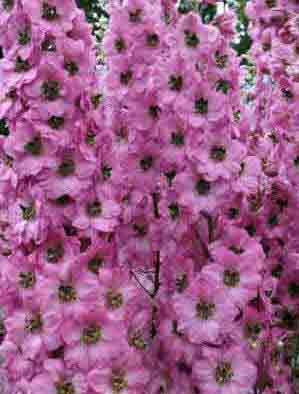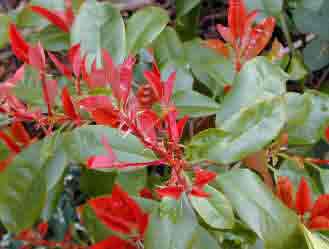Delphiniums – Care and How to Grow
Delphinium Elatum Group is the mainstay of the herbaceous perennials that grace borders and beds with tall flower spikes of mainly blue flowers. There are other colours available, such as white, cream and pink, but the Delphinium is famed for is radiant blue spires – sometimes 6 feet (2m) tall.
The individual flowers are massed on long single stems reaching skyward from the foliage base. Many varieties have bi-colour petals – blue with white being the most common - and a rage of flower types from open single individual blooms to fully double clusters.
As well as spectacular flowers, the Delphinium plants are graced with clumps of attractive palmate and lobed leaves making for a good base and foil below the spiked inflorescences. These are particularly attractive in early spring as they are awakening from their winter hibernation.
In the wild, the species are to be found in virtually every country in the world – with the strange exception of Australia. The natural habitat for most being mountains and high land area.
The cultivated forms that we adore are all happy to be cared for in our herbaceous borders, beds and for a short time, containers.
**Contact with the foliage can cause skin irritation in rare cases, and all parts substantial digestive problems if eaten.



Images © David Hughes
Delphiniums also blend in well with shrub plantings and even wild gardens as long as they are not crowded out.
How to Grow and Care for Delphiniums
Delphiniums are not particularly difficult to grow, but they do require a bit of basic care and management for success. If you simply want to plant and forget, then Delphinium flowers are not for you!
The main requirement – once all the other planting details are absorbed and implemented – is that of supporting the tall flower spikes. (You can grow dwarf varieties which will not require as much support.) A bamboo cane is almost an essential for growing the taller varieties, though there are various wire frames that can be raised up the plant as it grows.
The other main area of concern is the prevention of slugs in spring – and to a lesser extent through the early summer.
Delphiniums should be planted in a moderately fertile soil, with the overriding essential, that is should be a well drained – preferably light soil. A bright sunny open aspect is best and if also sheltered will help in the stability of the towering blooms spikes. Placing at the back of a border will afford some protection – especially if backed by a hedge or fence.
The soil type in relation to acidic or alkaline seems not to be a major factor. Somewhere in the middle being the optimum.
Allow Delphiniums to show off as only they can, by not overcrowding with other plants. They are stunning if planted as single specimens, but a group of mixed colours also attract attention and brightens up the mid to late summer.
The roots – either fibrous or fleshy – have a tendency to be shallow rooting, so care is required if hoeing around to suppress weeds – far better to do this by hand. Once the foliage canopy has grown, it will block out most weeds.
Feeding is rarely necessary, though a pre-growing season dressing of bone meal or Osmocote slow release fertilizer certainly helps. A mulch applied in winter will be appreciated, but not too deep around the crown of the plant.
Watering Delphiniums
Originating in mountainous areas gives the clue that Delphiniums prefer a moist soil, and should therefore be freely watered in dry times. A soaking rather than a sprinkling is better. This will obviously provide a good environment for slugs to hide under the foliage canopy!
Cut off the flowered spikes as soon as flowers fade to allow the plants added vigour to provide you with a succession of flowers – well into late summer.
Delphiniums are superb subjects for indoor flower arranging, and often used at weddings and other auspicious occasions. Plant enough, allow the cutting and you will still get a long succession for blooms.
Propagating Delphinium Plants
The main option for variety, is sowing seed in early spring. The best success rate is with a not-too-hot environment – soil temperature of around 12 – 14 degreed C. Control carefully if in a heated propagator. The plants will flower later in the year.
Option 2 with seeds is to sow in the autumn and over-winter the young plants.
For selected existing plants, basal cutting of stout stems – thickness of a pencil – taken off the parent plant early into the growing season and then treated as softwood cuttings. They root quite well.
Problems with Delphiniums
The main pest is slugs – and snails – hungry for an early spring feast after a long winter. The young plants can be protected from these predators by encircling the plant area with a layer of coarse grit. Titivate – loosen – the grit from time to time as it settles into a ‘path’ otherwise. Otherwise (and also) use slug pellets or you preferred method of keeping the ‘slimies’ at bay.
An annoying, though not too damaging pest is that of leaf miner bugs which disfigure the foliage. They can be seen at the ends of their tunnels and squashed with finger and thumb!
Established plants may suffer from a rot at the crown of the plant. In which case, start again with new plants!
Powdery mildew is a minor problem – even if a bit unsightly. Good air circulation and watering when dry helps to keep this at bay – preferably watering in early morning, to allow any foliage splashes to dry quickly. Evening watering can leave the foliage damp into the night.
- Other Tall Perennials include - Lupins | Hollyhocks |
Best Selling Gardening Products
Popular Gardening Sections

Problems
Identify Weeds in The Garden - How to deal with weeds. Diseases and Pest which harm your garden and plants, learn how to prevent, deter and erradicate your garden problems.
Garden Problems
Pruning
Pruning Guide. Shrubs flower better with correct pruning. Many illustrations and examples of what to do - and when. Includes evergreens, roses, flowering shrubs, spring flowering shrubs and pruning for stem effect. This is our most viewed and comprehensive section,
Pruning
Gardening Businesses
Gardening Businesses listed in the UK counties and USA states. County and State Listings of businesses involved in Garden supplies and services. If you wish to be added to the Directory, please send us your information. Having problems, use the search box
Businesses
Gardening
In this section you will learn about Gardening Basics, Containers, Landscaping, Propagation and Soil.
Gardening
Gardening Gifts
Gardening Gifts and Reviews, Read Before you Buy
- Gardening Gifts Ideas
- Gifts For Her
- Gifts For Men
- Power Tool Gifts
- Cheap Gifts
- Personalised Gifts
- Wildlife Gifts
- Family Gifts



